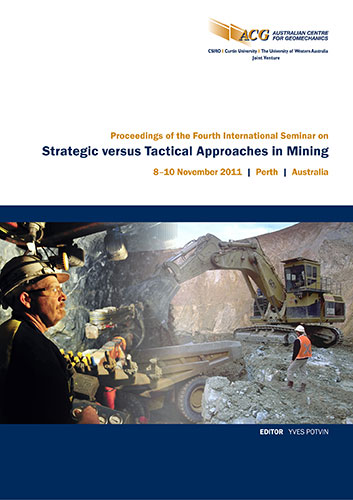Simple calibration of the extension strain criterion for its use in numerical modelling

|
Authors: Louchnikov, V |
DOI https://doi.org/10.36487/ACG_rep/1108_08_Louchnikov
Cite As:
Louchnikov, V 2011, 'Simple calibration of the extension strain criterion for its use in numerical modelling', in Y Potvin (ed.), Strategic versus Tactical 2011: Proceedings of the Fourth International Seminar on Strategic versus Tactical Approaches in Mining, Australian Centre for Geomechanics, Perth, pp. 85-96, https://doi.org/10.36487/ACG_rep/1108_08_Louchnikov
Abstract:
Calibrating numerical models is generally considered to be a rather time-consuming exercise which commonly involves a number of activities such as obtaining instrument readings, observing and mapping progressive rock mass damage, conducting various rock tests and surveying. While it is certainly absolutely necessary to undertake all these actions to make numerical models a working tool, quite often site personnel have no time or resources dedicated for a proper calibration process. In this paper, a simple technique of measuring fractures in drill holes around development drives and then relating the damage patterns to the extension strain contours modelled in a boundary element method (BEM) code is discussed. This technique has been used by the author at a number of operations and was found to be practically effective. A case study is presented where such calibration is shown to be instrumental in deciding on the optimal mining sequence in overstressed ground.
References:
Atlas Powder Company (1987) Explosives and Rock Blasting, 662 p.
Coulomb, C.A. (1779) Essai sur une application des règles de maximis et minimis à quelques problèmes de statique, relatifs à l’architecture, Mémoires de mathématique et de physique, présentés à l’Académie Royale des Sciences par divers savans, Vol. 7, pp. 343–382.
Fairhurst, C. (1964) On the validity of the ‘Brazilian’ test for brittle materials, International Journal of Rock Mechanics and Mining Sciences, Vol. 1, pp. 515–546.
Fairhurst, C. and Cook, N.G.W. (1966) The phenomenon of rock splitting parallel to the direction of maximum compression in the neighbourhood of a surface, in Proceedings 1st Congress of the International Society for Rock Mechanics, Lisbon, September 25–October 1, Vol. 1, pp. 687–692.
Franklin, J.A. (1971) Triaxial strength of rock material, Rock Mechanics, Vol. 3, pp. 86–98.
Griffith, A.A. (1924) Theory of rupture, in Proceedings 1st International Congress of Applied Mechanics, C.B. Delft Biezeno, J.M. Burges (eds), pp. 55–63.
Hoek, E. and Brown, E.T. (1980) Underground excavations in rock, London: Institute of Mining and Metallurgy.
Holmberg, R. and Persson, P. (1978) The Swedish approach to contour blasting, in Proceedings of Conference on Explosives and Blasting Techniques, Society of Exploration Engineering, February 1–3, New Orleans, USA.
Kuijpers, J. (2000) Fracturing around highly stressed excavations in brittle rock, Journal of the South African Institute of Mining and Metallurgy, Vol. 100, pp. 325–332.
Ndlovu, X. and Stacey, T.R. (2007) Observations and analyses of roof guttering in a coal mine, Journal of the South African Institute of Mining and Metallurgy, Vol. 107, pp. 477–491.
Sheorey, P.R., Biswas, A.K. and Choubey, V.D. (1989) An empirical failure criterion for rocks and jointed rock masses, Engineering Geology, Vol. 26, pp. 141–159.
Stacey, T.R. and De Jongh, C.L. (1977) Stress fracturing around a deep level bored tunnel, Journal of the South African Institute of Mining and Metallurgy, Vol. 78, pp. 124–133.
Stacey, T.R. (1981) A simple extension strain criterion for fracture of brittle rock, International Journal of Rock Mechanics and Mining Sciences, Vol. 18, pp. 469–474.
Wiles, T.D. (2011) Map3D V.57, www.map3d.com.
© Copyright 2026, Australian Centre for Geomechanics (ACG), The University of Western Australia. All rights reserved.
View copyright/legal information
Please direct any queries or error reports to repository-acg@uwa.edu.au
View copyright/legal information
Please direct any queries or error reports to repository-acg@uwa.edu.au